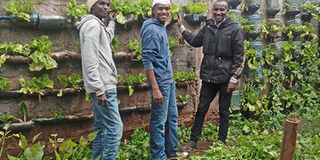Yes, you can turn your security wall into garden

Ephantus Karenju, Kennedy Mzalendo and Bube Karanja pose next to their wall farm in Uthiru, Kiambu County. The trio is currently harvesting and selling lettuce that they have cultivated on the farm. PHOTO | PAULINE ONGAJI | NATION MEDIA GROUP
What you need to know:
- The bottles range from one to five litres in capacity, which are cut using a razor or knife, holes made at the bottom and then filled with soil, sand and organic manure and then fastened onto the wall using a piece of wire.
- The trio change the soil in the bottles every three months to avoid exhaustion of nutrients. Kathia Mwenda, an agribusiness consultant at Aithak Group Limited, says urban farming gardens assure families of constant food supply.
- They not only sell their produce at City Market in Nairobi, but also have clients in the neighbourhood. More money comes from installing the gardens for families.
- Karanja is the brain behind the project, a dream that began in 2008 after he joined an environmental conservation project called Geo-Wild Kenya Society.
The four-metre-high wall surrounding the compound in Uthiru, Kiambu County, is impressive by any standards; erected to keep all kinds of unwanted agents at bay.
But the wall is offering more than just security, as it is also a farm where three young men grow their crops.
Ephantus Karenju, 27, Kennedy Mzalendo, 27 and Bube Karanja, 36, have turned the wall into a vibrant farm that hosts all kinds of vegetables.
“This is our farm,” says Karenju as he adjusts a bottle hosting three sukuma wiki (collard green) plants. “We have hundreds of plants here, all grown in recycled bottles hanging on this wall,” he adds.
The bottles range from one to five litres in capacity, which are cut using a razor or knife, holes made at the bottom and then filled with soil, sand and organic manure and then fastened onto the wall using a piece of wire.
“We arrange the small bottles mostly horizontally, and the bigger ones vertically. We fill in a mixture of loam soil, animal manure and sand before planting the seedlings,” explains Karanja, whose parents’ home is hosting the garden that they used Sh3,500 to set up.
According to him, sand is useful in aeration, as well as allowing water to infiltrate the soil and reach the plants. “This is urban farming. It works well for plants with short roots such as lettuce and spinach,” says Karenju.
“Preferably, we plant lettuce because they mature faster and don’t require a lot of work.” Seeds are first planted in the nursery then transferred to the bottles after two or three weeks.
“Plants on the laterally arranged bottles must be watered one by one. On the other hand, for the vertical bottles, one only waters the top one and the water trickles down,” explains Mzalendo, who studied banking at Kabete Polytechnic. He observes that it is easier for them to get the small bottle than the bigger ones.
CONSTANT FOOD SUPPLY
“That is one of the reasons we have embraced both methods because while it is easier to get the smaller bottles, the vertical arrangement saves space and the bigger bottles host more plants.”
The trio change the soil in the bottles every three months to avoid exhaustion of nutrients. Kathia Mwenda, an agribusiness consultant at Aithak Group Limited, says urban farming gardens assure families of constant food supply.
“The good thing with the garden is that it is easier to deal with pests and diseases as one can easily scout for them. However, an integrated crop protection approach involving chemical spraying and bio-pesticides works best,” he explains.
The trio is currently harvesting and selling lettuce. “We sell each plant at Sh40 and in a good harvest end up with Sh15,000,” says Karanja.
They not only sell their produce at City Market in Nairobi, but also have clients in the neighbourhood. More money comes from installing the gardens for families.
“So far we have installed them for two individual clients in Muthiga and Kinoo. We have also set up the gardens at Kabete Polytechnic, Shangilia Mtoto wa Afrika Home and the Kangemi’s chief’s camp. We currently have several online requests from as far as Mombasa, but the problem is that still we do not have the money to travel there for such assignments,” said Karanja, noting they charge Sh5,000 to install the garden.
Karanja is the brain behind the project, a dream that began in 2008 after he joined an environmental conservation project called Geo-Wild Kenya Society.
“We used to collect the bottles but disposing of them became a problem. That is why I thought this would be a great idea,” he says.
So in 2014, through trial-and-error, he launched the project and was later joined by Mzalendo and Karenju, who have studied business management.
“These gardens not only offer households food but also beautify homes. Most homes in and around the city have security walls. I see them as gardens. We can also utilise buildings’ walls,” says Mzalendo.





